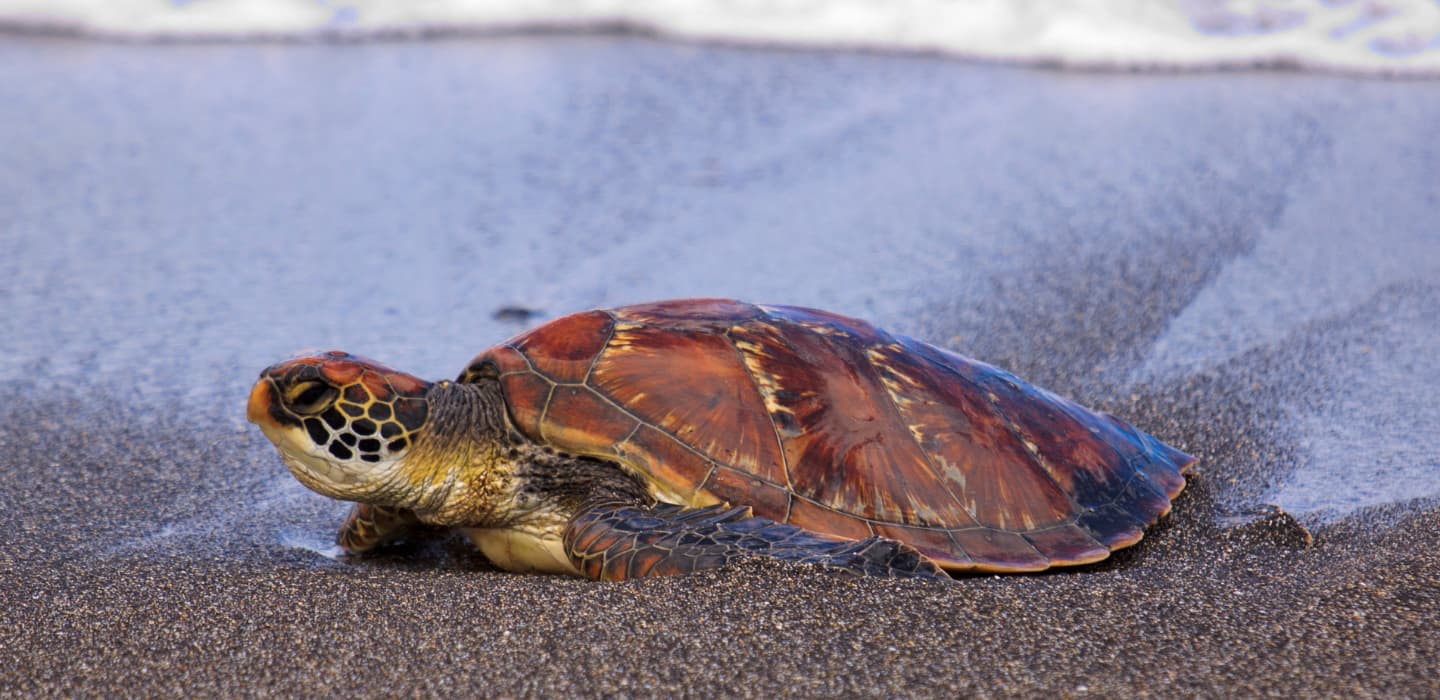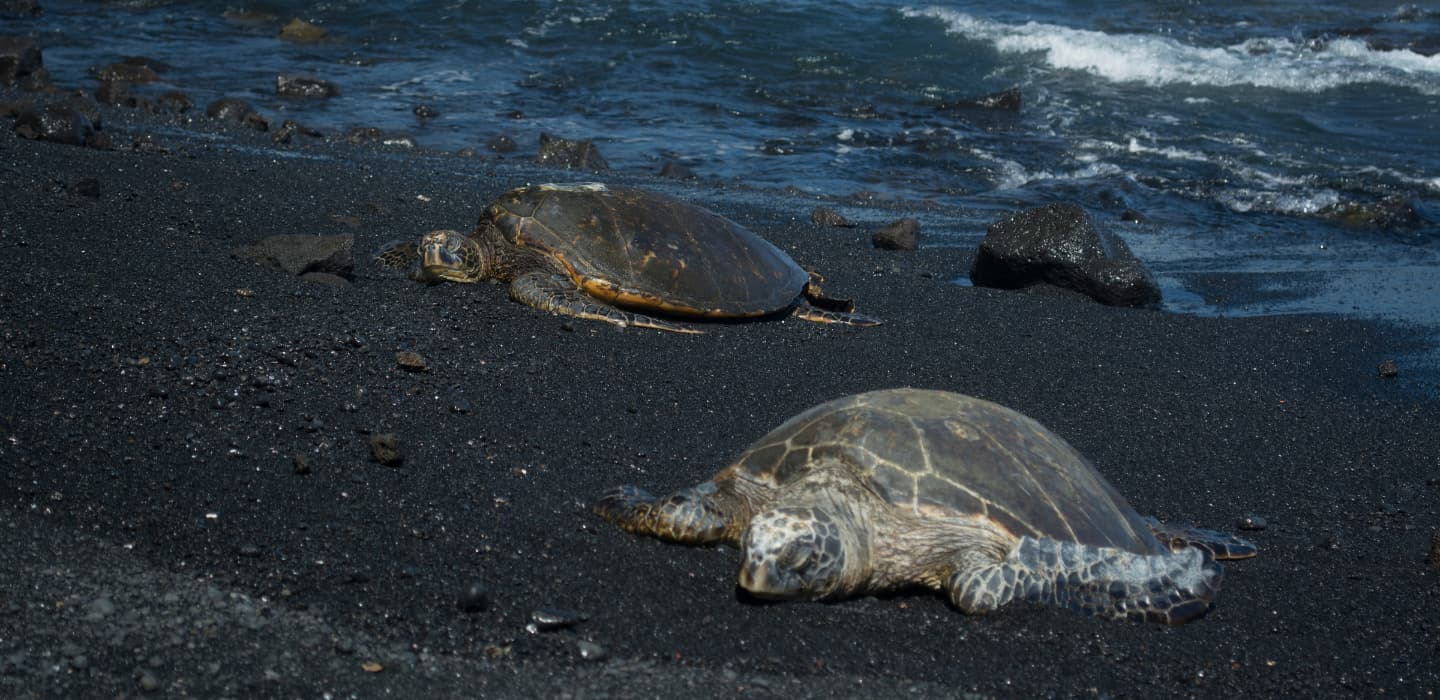Sea turtles have roamed our oceans for over 100 million years, silently witnessing countless changes in our planet’s history. In the stunning archipelago of Hawaii, these marine ambassadors glide gracefully through the cerulean waters, reminding us of nature’s wonder and our role in preserving it. Join us on this journey as we dive deep into the world of Hawaii’s sea turtles, the gentle giants of the Pacific.
If you’ve ever been curious about these majestic sea dwellers or dreamt of spotting them up close during your island visit, this post is for you!
The Wonders of Hawaiian Sea Turtles
Hawaii turtles play an essential role in maintaining the health of marine ecosystems. Plus, they’re deeply rooted in Hawaiian culture and folklore. While the green sea turtle is the most common species in Hawaiian waters, the islands play host to several other sea turtle species:
The Green Sea Turtle or ‘Honu’: Recognizable by their heart-shaped shells and herbivorous diet, primarily of seagrasses and algae. These commonly encountered sea turtles are unique due to their distinctive internal fat tissue that turns green from consuming an algae-rich diet. They’re quite impressive in size, with shell lengths averaging 4-5 feet and weighing between 200-250 pounds. Today they enjoy protection under the Endangered Species Act but continue facing challenges such as climate change, which impacts their nesting sites.
Hawksbill Sea Turtle (Honu’ea): Distinguished by their hawk-like beaks and colorful shells, they are critically endangered and rarely seen.

Loggerhead and Leatherback Sea Turtles: Though these species primarily nest in other parts of the world, they occasionally appear in Hawaiian waters.
Like many marine species, Hawaii’s sea turtles face several threats, both natural and man-made:
- Entanglement & Marine Debris: Abandoned fishing nets, plastic waste, and other debris can entangle and harm sea turtles.
- Climate Change: Rising sea levels may erode beaches, affecting nesting sites. Additionally, temperature determines the sex of hatchlings; skewed ratios can result from abnormal temperatures.
- Human Disturbance: Direct contact or close proximity to humans can stress turtles. It’s important for beachgoers to give them space, especially nesting females.
- Habitat Destruction: Coastal development can disrupt and destroy vital nesting and feeding grounds.
Conservation Efforts
Fortunately, Hawaii’s sea turtles have become iconic ambassadors for marine conservation, prompting several initiatives:
Marine Protected Areas: The Papahānaumokuākea Marine National Monument, the largest marine conservation area in the world, spans 139,797 square miles of the Pacific Ocean. It derives its name from two Hawaiian ancestors credited with creating the Hawaiian Archipelago. Papahānaumoku and Wākea are also credited with cultivating taro plants and giving birth to the Hawaiian people. The sanctuary is a haven for diverse marine species, including sea turtles. Unfortunately, it is not accessible to the general public; however, you can explore this remarkable region virtually through the Virtual Visits page.
Rescue & Rehabilitation Centers: Facilities like the Maui Ocean Center’s Marine Institute rescue, rehabilitate, and release injured sea turtles.
Education & Outreach: Organizations conduct programs to educate the public about sea turtles, their significance, and how to coexist without causing them harm.
Experience the Magic: Where to Spot Sea Turtles on the Big Island
Punalu’u Black Sand Beach, Big Island: This beach is famous among tourists and locals as one of the top spots to observe Hawaiian green sea turtles. The striking contrast between their shells and the black sand makes them easy to spot. However, it’s important to admire and respect these animals by avoiding any physical contact or disturbance.
Kahalu’u Beach Park: Besides being a hotspot for snorkeling enthusiasts due to its rich marine life, Kahalu’u serves as an essential feeding ground for sea turtles. You might even get lucky enough to witness local ‘turtle cleaning stations’, where smaller fish help maintains our long-lived friends’ health by removing algae from their shells.

How to Behave Around Turtles
The ‘Honu’, Hawaiian green sea turtles, are more than just a familiar sight on Hawaii’s beaches; they possess immense cultural value and symbolize wisdom in local legends.
How do we show our respect for these majestic creatures? Well, it starts with keeping your distance. Federal law mandates that you stay at least 10 feet away from them on land and underwater – close encounters can cause unnecessary stress and disrupt their natural behavior, and don’t use flash photography when taking pictures.
If you spot green sea turtles calmly cruising the reef while snorkeling or diving, resist the urge to touch or chase after them.
The Hawaiian Wildlife Fund, https://www.wildhawaii.org/, is an excellent resource for any distressed or injured turtle you might see, like one tangled in rope or fishing wire. Don’t try to rescue them yourself. Leave it to the professionals.
FAQs in Relation to Hawaii Turtles
The Green Sea Turtle, or Honu, is the most prevalent sea turtle in Hawaiian waters.
In Hawaiian culture, sea turtles symbolize longevity, safety, and spiritual energy. They are considered ‘aumakua or family guardians, which makes them sacred.
Hawaiian sea turtles are commonly referred to as “Honu,” a term used for the green sea turtle species native to Hawaii.
The large-sized marine creatures often spotted around Hawaii’s shores and waters are Green Sea Turtles, locally known as Honu.
Our Hawaii bed and breakfast serves as your perfect base for visiting Black Sand Beach, where you will often find turtles in the surf or sunning on the beach

